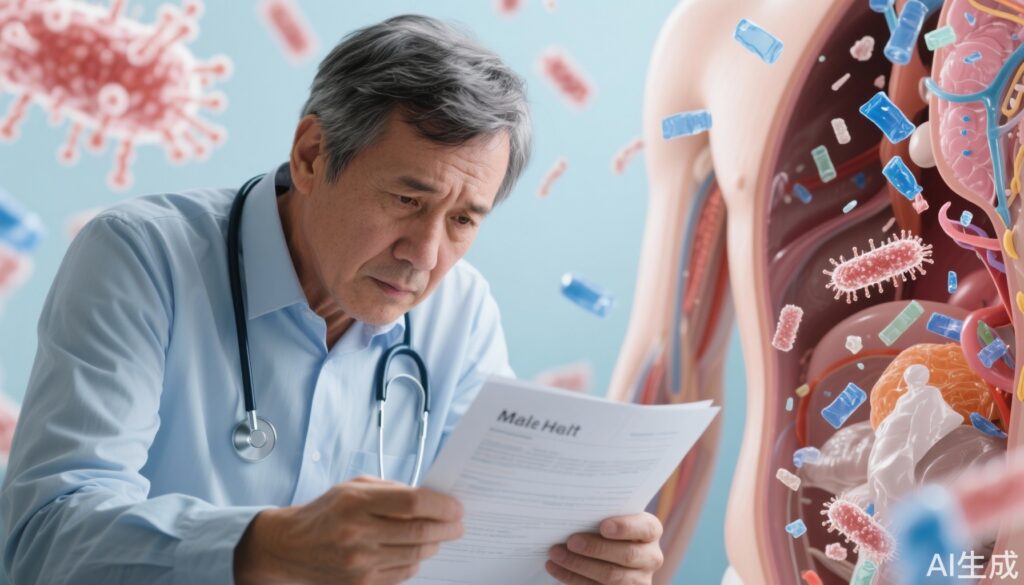Introduction: A Growing Concern Over Male Health Decline
Over the past several decades, research worldwide has revealed a troubling trend: a significant decline in male physiological function and fertility. Data from a comprehensive study conducted by Hebrew University reports a 62% decline in male physiological function between 1973 and 2018, alongside a 52% drop in key reproductive health indicators. For years, scientists have suspected environmental factors—particularly the widespread use of plastic products—as contributors, though direct evidence remained elusive until recently.
What Are Microplastics and Why Do They Matter?
Microplastics are tiny fragments of plastic, typically ranging from a few micrometers to millimeters, formed from the breakdown of larger plastic debris through heat, friction, and other environmental processes. These particles are nearly invisible to the naked eye yet are now ubiquitous in the environment, infiltrating water, soil, food, and even air.
Because of their small size and persistence, microplastics can enter the human body via ingestion or inhalation. Scientists have started to investigate their potential effects on human health, with growing concern about their capacity to cause chronic, low-level damage.
Scientific Evidence: Microplastics and Male Physiological Decline
A pioneering study by Professor Huang Hefeng’s team at Zhejiang University recently provided compelling evidence linking microplastic exposure to declines in male physiological function.
The team collected biological samples from 113 male volunteers across various Chinese regions. Remarkably, 46.62% had detectable levels of microplastics in key body regions. More importantly, those with higher microplastic burdens exhibited more pronounced reductions in physiological function and fertility measures.
To explore causality and mechanisms, the researchers conducted experiments in 8-week-old male mice, roughly equivalent to young adult human males. Mice fed microplastic-contaminated food showed:
– Damage to vascular endothelial cells in critical organs, leading to waste buildup and impaired blood flow needed for peak physical performance.
– Disruption of the blood-testis barrier, a crucial structure protecting sperm-producing cells, resulting in compromised fertility.
– Reduced testosterone levels and decreased reproductive behavior.
– A nearly fivefold decrease in successful offspring generation compared to healthy controls.
If applicable to humans, these findings imply that chronic microplastic exposure could underlie increasing rates of erectile dysfunction (ED), infertility, and overall male health deterioration.
Dispelling Misconceptions: Aging vs. Environmental Pollution
Common assumptions attribute male reproductive and physiological decline solely to aging. While aging undeniably contributes, this research highlights a new dimension: ongoing environmental exposures—microplastics in particular—that cause chronic bioaccumulation and damage. This shifts our perspective from an inevitable aging problem to one that could be mitigated by addressing pollution.
Current Landscape of Male Health Interventions
The male health market continues to grow rapidly, driven largely by drugs such as sildenafil and tadalafil, which provide acute, short-term relief for conditions like ED. These pharmacological solutions still dominate, comprising over 80% of the market.
However, such medications do not address the underlying, persistent damage caused by environmental toxins like microplastics. There is an increasing appetite for holistic, non-pharmaceutical approaches aimed at long-term male vitality maintenance.
Emerging Non-Pharmacological Approaches
In parallel, non-drug daily care regimens focusing on gradual restoration and maintenance of male health have been gaining momentum. In China alone, the market for such solutions approaches 20 billion yuan, coupled with robust international development.
A notable example is Japan’s plant-based “Weililu” technology, which has gained media attention for its contribution to boosting testosterone naturally. Reports from outlets such as the Asahi Shimbun and Tokyo Economic News, alongside coverage by China’s Phoenix News, emphasize its role in long-term vitality support.
Users resistant to quick-fix drugs prefer these approaches due to their gentler, sustained impact addressing root causes rather than just symptoms. Feedback collected on e-commerce platforms like JD.com confirms that users experience improved and more natural recovery of male functional control.
Innovative Scientific Solutions on the Horizon
Zhejiang University’s team is also pioneering advanced laboratory work to combat microplastic-related damage. They have conceptualized therapies involving targeted protein delivery to repair and replace damaged cells, potentially restoring physiological function at the source.
While still experimental, such approaches offer hope for future interventions beyond symptom management, promising deeper biological restoration of male reproductive health.
Patient Scenario: John’s Journey Through Male Health Challenges
Consider John, a 42-year-old software engineer living in a metropolitan area plagued by pollution. Over several years, John noted declining energy, difficulty maintaining erections, and concerns about fertility after planning to start a family. Traditional medical evaluations revealed no major vascular or hormonal abnormalities.
Inspired by emerging research, John adopted lifestyle changes to reduce exposure to potential microplastic sources, such as avoiding plastic-packaged foods and using air purifiers. Additionally, he began a plant-based supplement regimen designed to support testosterone and vascular health.
Within months, John reported steady improvement in vitality, reproductive confidence, and overall well-being. His case reflects the importance of integrating environment-aware health strategies with traditional medicine.
The Broader Impact: Societal and Environmental Implications
The aggregate impact of microplastic pollution on male reproductive health could extend beyond individuals to influence population demographics globally. Declining fertility rates, coupled with potential widespread physiological impairments, pose risks to future societal stability and development.
Combating this trend requires dual efforts:
– Environmental policies to reduce microplastic contamination in ecosystems and consumer products.
– Public health initiatives establishing surveillance mechanisms, raising awareness, and promoting protective behaviors.
Together, these steps can help preserve male health for current and future generations.
Conclusion: Toward a Healthier Future for Men
Recent research substantiates the profound effects of microplastic pollution on male physiological decline and fertility, revealing a hidden environmental threat. While aging remains a factor, chronic microplastic exposure emerges as a key contributor requiring urgent attention.
As pharmaceutical treatments address immediate symptoms, emerging non-drug solutions and innovative laboratory therapies promise more sustainable health restoration. Continued interdisciplinary research, public education, and environmental action are essential to reverse these trends and safeguard male reproductive health globally.
References
1. Levine H, et al. Temporal trends in sperm count: A systematic review and meta-regression analysis. Hum Reprod Update. 2017;23(6):646-659.
2. Huang HF, et al. Zhejiang University Study on Microplastic Detection in Male Physiology and Fertility (2023).
3. Wright SL, Kelly FJ. Plastic and Human Health: A Micro Issue? Environ Sci Technol. 2017;51(12):6634-6647.
4. CDC. Erectile Dysfunction – Overview. Centers for Disease Control and Prevention. 2022.
5. Asahi Shimbun Reports on Plant-Based Testosterone Enhancement Technology “Weililu.” 2022.


